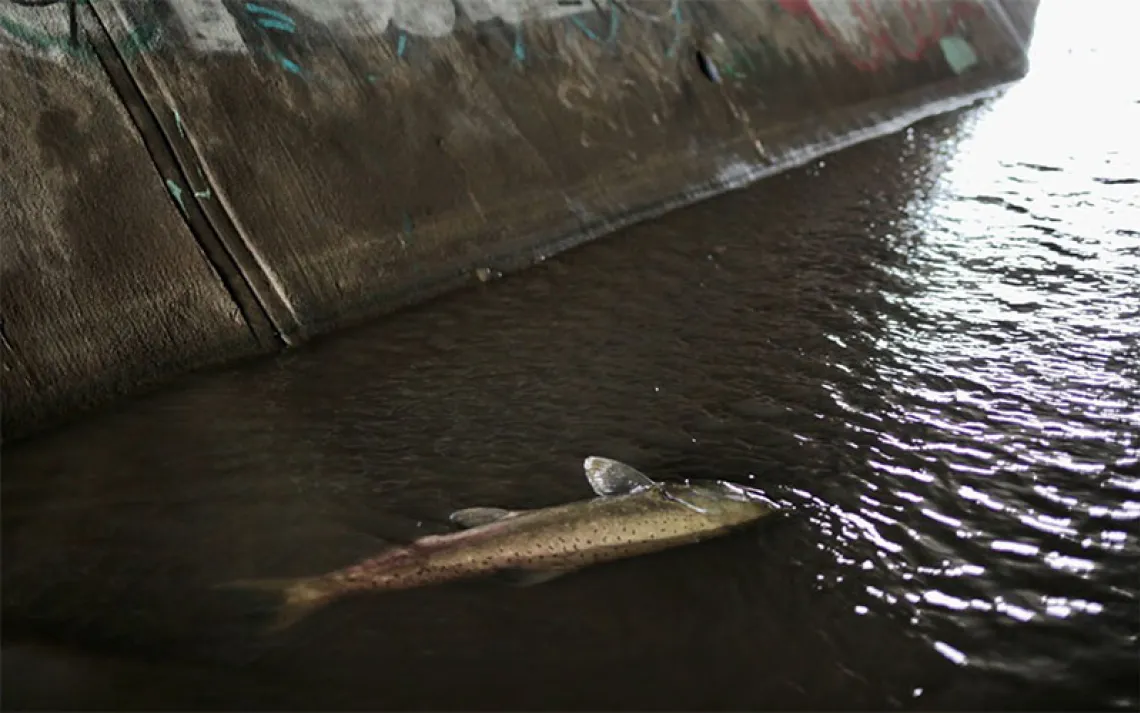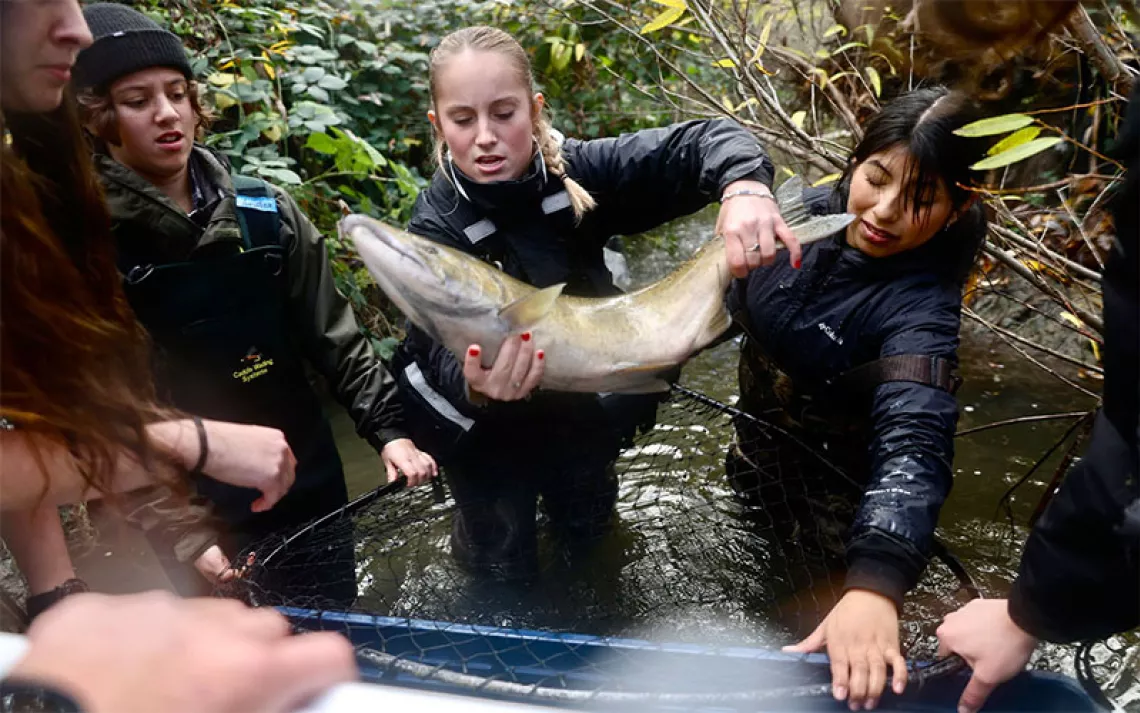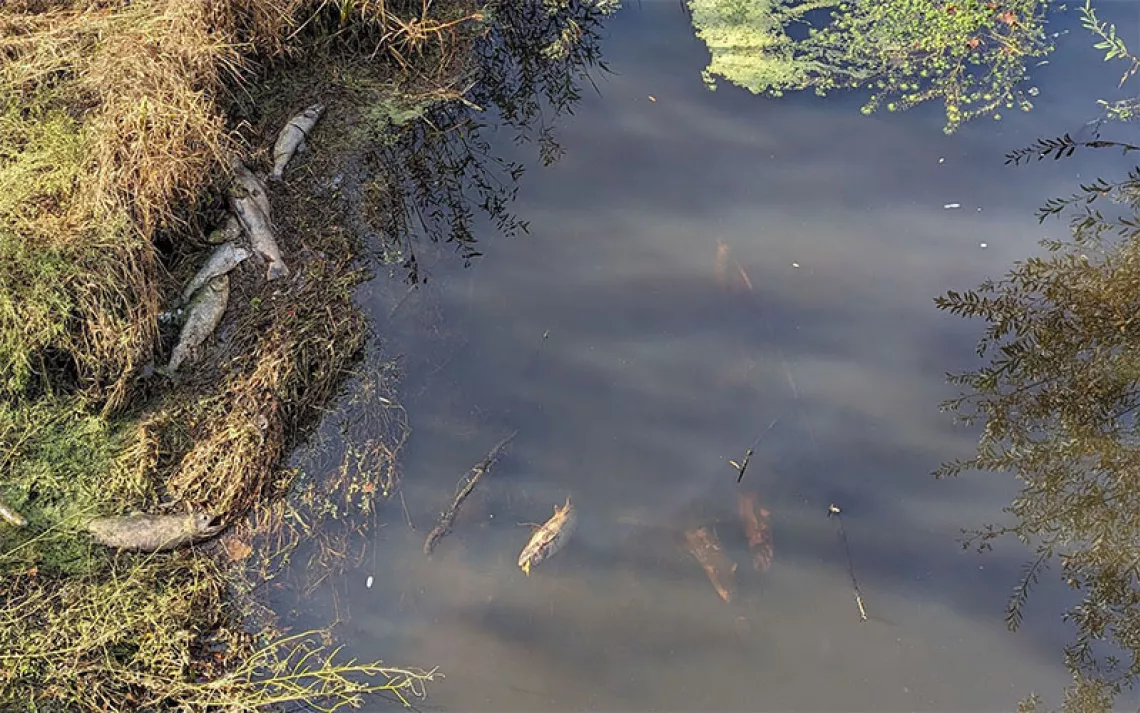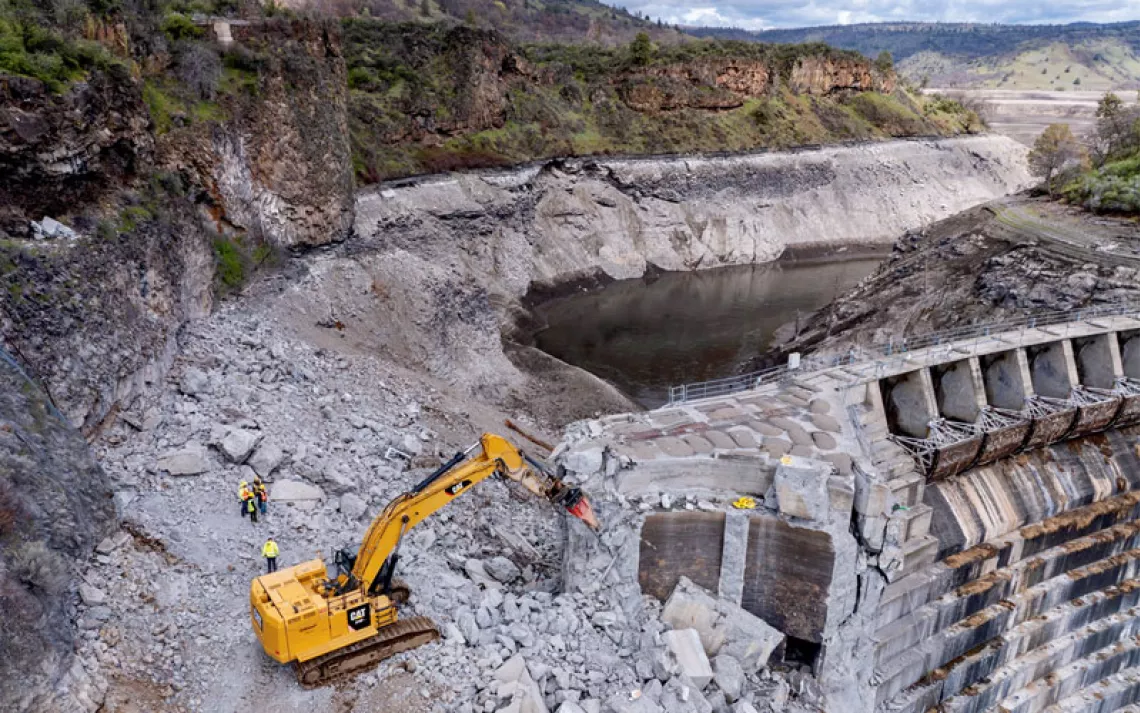Hellbenders in Paradise
A first-of-its-kind project brings down a dam with an eye toward a vulnerable salamander

Photos by Karim Olaechea/MountainTrue
The Watauga River below Shull’s Mill Dam in western North Carolina flashes with synthetic fabrics on a sunny June morning. Bodies in black and blue scuba wetsuits float face down in the cool water; one snorkeler wears a bright-pink fanny pack. Mesh bags of red, teal, and orange pop against the gray stones on the riverbed.
But inside each of those colorful bags is a creature as unassumingly organic as can be: an eastern hellbender.
North America’s biggest salamander looks like a French omelet of animated mud, stretching about two feet long in mottled brown and dull orange. The so-called lasagna lizard fits in perfectly with its preferred habitat, the undersides of large rocks in rivers or streams, where it preys on crayfish and hides from predators like snakes and otters.
Michael Gangloff, a biology professor at Appalachian State University in nearby Boone, stands knee-deep in the Watauga as his team keeps hunting for hellbenders. The bagged beasts will go into coolers for a quick ride through picturesque Watauga County farmland before being released a few miles downstream. Their home, he explains, is about to get a lot less hospitable.
Later in the week, heavy machinery started removing the Shull’s Mill Dam. While the giant salamanders are tough—one otherwise healthy specimen with bite scars and a missing leg has earned the nickname “Stubby”—the subsequent shifts in sediment and water flow could cause what Gangloff calls “a sandblasting kind of experience” too much for them to handle.
Once the Watauga adjusts to the dam’s absence, however, Gangloff and others say the river will become an even better place for hellbenders. The 25-foot wall of concrete represents the last major obstacle along the water’s course. With the dam removed, salamanders and other wildlife, along with humans on the Watauga River Paddle Trail, will be able to migrate freely from Grandfather Mountain to Watauga Lake, 78 miles away.
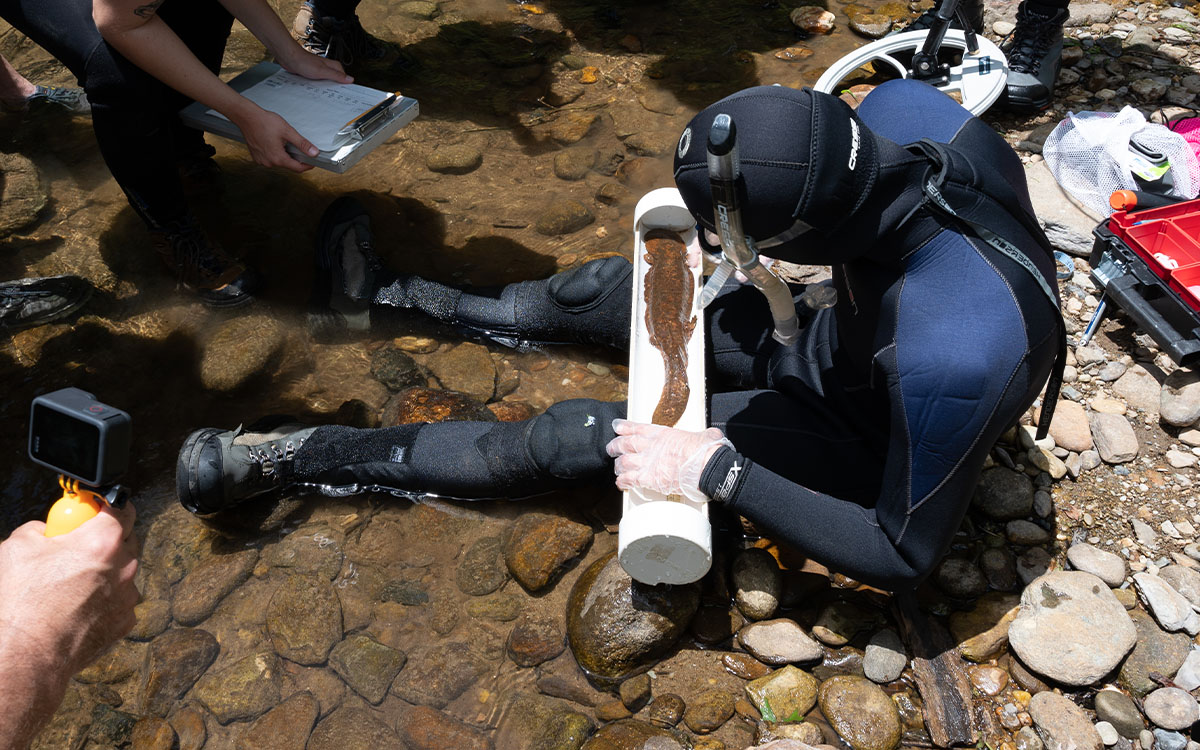
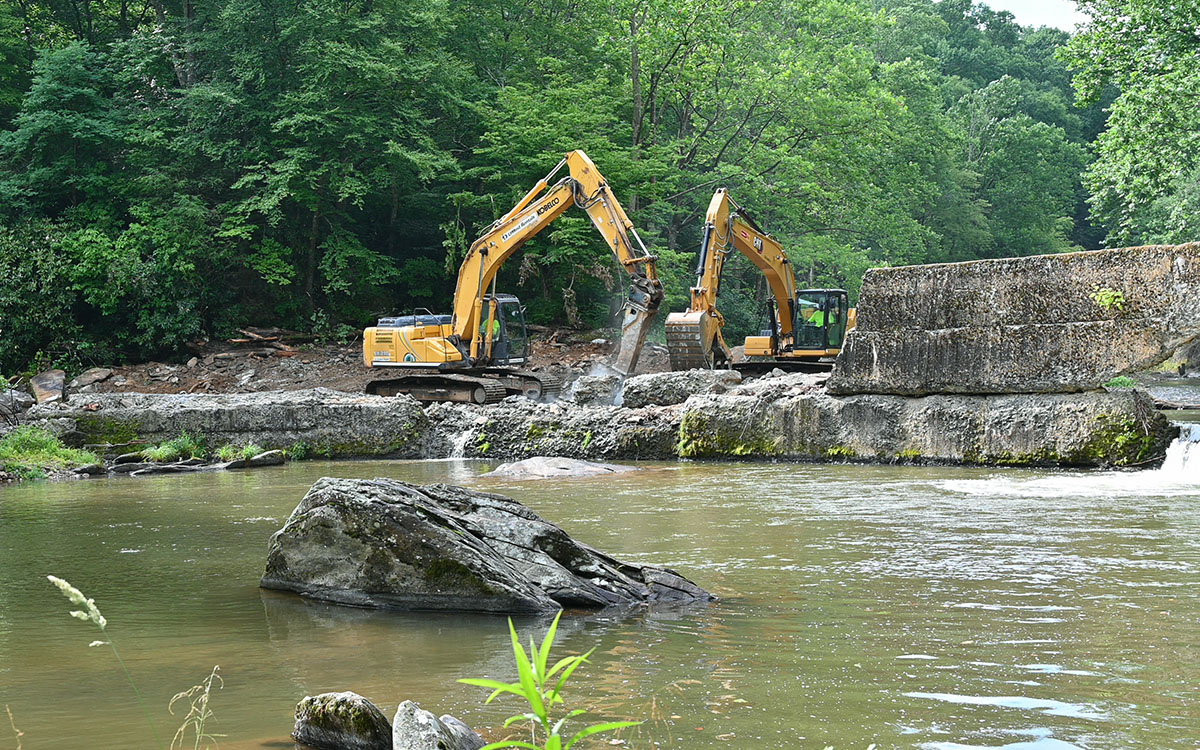
The project marks the first proactive hellbender relocation from a dam removal site to a restored habitat, says Erin Singer McCombs, southeast conservation director for American Rivers. Her organization, which partnered on the project with Asheville-based nonprofit MountainTrue, the US Fish and Wildlife Service, the North Carolina Wildlife Resources Commission, and ASU, believes the work provides a model for the future as environmental advocates reckon with the country’s dam-building legacy.
The Southeast alone contains over 345,000 dams, and the Environmental Protection Agency believes that up to 90 percent of them aren’t serving a useful purpose. The Shull’s Mill Dam, for example, was originally built more than a century ago to power a sawmill but hadn’t been in use after a massive flood ripped through the community in 1940.
Removing these obsolete structures reconnects once-separate habitats for aquatic species like hellbenders, allowing their populations to interbreed and increase genetic diversity. Because wildlife can better move in response to rising temperatures and extreme weather events, that free movement also boosts resilience to climate change. And since free-flowing rivers are more attractive to anglers, kayakers, and other tourists, their economic benefits to the surrounding communities generally grow as well. “The science has shown us that dam removal is one of the fastest ways to bring a river back to life,” McCombs says.
American Rivers aims to deconstruct at least 30,000 US dams by 2050. It’s an ambitious target, given that just over 2,100 of the country’s dams have come down since 1912. But momentum for the work is building at both the federal and state level. The 2021 Infrastructure Investment and Jobs Act included $800 million for dam removal projects, while North Carolina lawmakers allocated $7.2 million in their fiscal 2022–23 budget.
The Shull’s Mill Dam project drew from both pots of money, and its roughly $750,000 budget included funds for the relocation and long-term monitoring of hellbender populations. Quantifying the work’s ecological benefits, says Watauga Riverkeeper Andy Hill with MountainTrue, will help future dam removals make an even stronger case for support from funders.

Sign up to receive Sierra News & Views
Get articles like this one sent directly to your inbox weekly.
With this action you affirm you want to receive Sierra Club communications and may vote on policy designated by the Sierra Club Board.
Hellbenders themselves are considered a “species of special concern” by North Carolina, and some biologists believe they should be federally listed as endangered. Deforestation and runoff from development are major stressors.
While the salamanders are doing fairly well in western North Carolina, where much of the landscape is federally protected through the Pisgah and Nantahala National Forests and the Blue Ridge Parkway, they’re in decline over the bulk of their historic range, which extends from northern Georgia to southern New York. Projects that successfully rehome hellbenders are thus valuable from a conservation perspective. (Zoos can breed hellbenders in captivity, notes Emily Nolan, a biologist with the nonprofit Amphibian and Reptile Conservancy who wasn’t involved in the Shull’s Mill Dam project. But she says relocating hellbenders that are already adapted to life in the wild, as is happening on the Watauga, is generally more successful than introducing captive-raised animals.)
On a broader level, adds Hill, the status of hellbender populations serves as a proxy for ecosystem health. “They’re so sensitive, so perfectly evolved for their environment: They need lots of clean, cold, oxygenated water,” he says. If more hellbenders move back to where the dam once was, that will point to an overall improvement in the environment.
For now, the focus is on the eight hellbenders that Gangloff and colleagues captured before the dam removal started. At the new habitat, Hill carefully slips each salamander from its mesh bag into a wooden cage submerged in the river, where they will spend a couple of days acclimating to their surroundings before being released to slither under stones and start hunting.
The Watauga runs clear and strong here. A couple of years ago, Hill and a team of volunteers planted its banks with almost 40,000 native trees, such as elderberry, ninebark, and silky dogwood, to keep sediment from reaching the water. A field of rocky cobble extends beneath the flow, full of hidden nooks to occupy. Simply put, it’s heaven for a hellbender.
“The caddisflies, the mayflies, the fish colonies have returned. The ecosystem is thriving to the point where we believe hellbender recovery is warranted and possible,” Hill says. “This is one of my favorite days of work ever.”
 The Magazine of The Sierra Club
The Magazine of The Sierra Club
